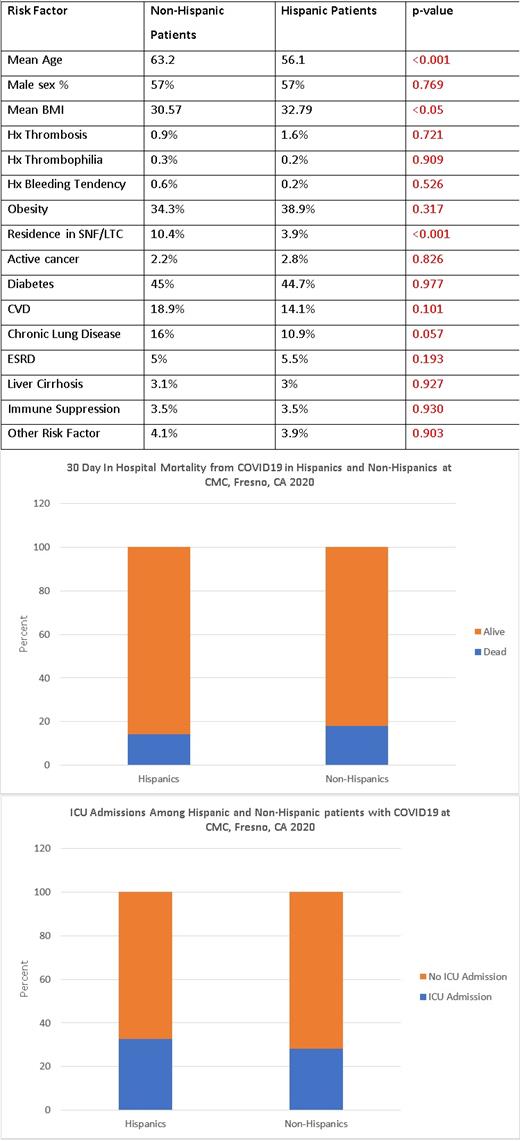Abstract

Background: The COVID-19 pandemic has brought a spotlight on the high incidence of thrombosis and abnormal coagulation parameters in patients with the 2019 novel coronavirus. We evaluated 30 day mortality and thrombotic events relative to anticoagulation therapy and coagulation parameters in Hispanic and non-Hispanic patients in California's central valley.
Methods: We identified 886 non-pregnant adults hospitalized at Community Medical Centers in the Central Valley of California with SARS-CoV2 infections from 3/1/20 to 9/1/20. We conducted manual chart review and excluded patients on long term anticoagulation prior to admission. We collected data on ethnicity, coagulation labs, thrombotic events and 30 day all-cause mortality outcomes. The distributions of variables were reviewed to detect illogical and out of range values. Differences in means of continuous variables were evaluated via the t-test. Differences in categorical variables were evaluated with chi square tests. All tests are two-sided and a p-value < 0.05 was considered statistically significant.
Results: Among the 866 COVID positive patients, 568 (64%) were Hispanic and 318 (36%) were non-Hispanic. The gender distribution was equivalent with 57% males and 43% females. Hispanic patients were younger with a mean age of 56.1 years vs 63.2 years in non-Hispanics. Mean BMI was 32.7 for Hispanics and 30.5 for non-Hispanics (p<0.05). The risk factor assessment for severe COVID-19 infection revealed a history of thrombosis or thrombophilia, bleeding tendency, obesity, active cancer, diabetes, cardiovascular disease, end stage renal disease, liver cirrhosis and immunosuppression, all of which were not statistically significant between Hispanics and non-Hispanics. However, chronic lung disease (p<0.05) and residing in a skilled nursing or long-term care facility (p<0.001) were statistically significant (Table 1). 16% of non-Hispanics had chronic lung disease vs 10.9% of Hispanics. Likewise, 10.4% of non-Hispanics inhabited care facilities compared to 3.9% of Hispanics. Review of initial CRP values exhibited statistical significance (p=0.017) amidst Hispanics at 145.3 and non-Hispanics at 124.8. Other labs including PT, INR, PTT, d-dimer, fibrinogen, platelets, ferritin and ESR were not statistically significant between ethnic groups.
Mean hospital stay for Hispanics and non-Hispanics were analogous at 12.8 days and 12.9 days respectively. Intensive care unit admission rates were higher for Hispanics at 32.7% (186/568) in contrast to non-Hispanics at 28.3% (90/318) (p=0.171). Evaluation of 30 day mortality revealed that 14.2% (81/568) of Hispanic patients died compared to 17.9% (57/317) of non-Hispanic patients. (p=0.147). The bleeding rate was 4.8% in Hispanics and 3.8% in non-Hispanics. 59 (6.6%) patients experienced some form of thrombosis, which was dichotomized to show that 39 (6.8%) Hispanics and 20 (6.2%) non-Hispanics incurred thrombosis during hospitalization. 19.4% (18/93) of patients on therapeutic anticoagulation and 5.1% (34/657) of patients on prophylactic low dose anticoagulation developed thrombosis (P=0.00001). 30 day mortality was higher in patients receiving therapeutic vs low dose standard anticoagulation prophylaxis (20.4% Vs 14.5%. p=0.006). Thrombotic events transpired at 4.7% (22/464) in patients with initial d-dimer <2500 in comparison to 15.8% (19/120) of patients with values ≥2500 (p<0.001). Additionally, 30 day mortality was lower for patients with d-dimer < 2500 at 13.4% (62/464) than for patients with d-dimer ≥ 2500 at 30.8% (37/120) (p<0.001). Prothrombin time (PT) > 16 correlated with a higher incidence of thrombosis (17% vs 6.7%. p<0.001) and 30-day mortality (36% vs 15.9%. p <0.001). Similarly, 30 day mortality was increased in patients with ferritin > 1000 (22.7% vs 12.1%. p= 0.002). However, the same was not observed for ferritin levels and thrombosis.
Conclusions: This study illuminates ethnic variances with respect to COVID-19 hospital outcomes. Hispanic patients were younger and had less risk factors for severe COVID-19 infections. Regardless of ethnic differences, incidence of thrombosis and 30 day mortality were similar. Despite sicker patients receiving therapeutic anticoagulation, the 30 day mortality and rate of thrombotic events remain higher among these patients. D-dimer ≥ 2500 and elevated PT were associated with higher rate of thrombosis and death.
Abdulhaq: BMS, Alexion, Oncopeptides, Morphosys, Pfizer, Norvartis: Honoraria; Oncopeptides, Alexion, Amgen: Speakers Bureau; Morphosys, BMS, Amgen: Membership on an entity's Board of Directors or advisory committees.
Author notes
 This icon denotes a clinically relevant abstract
This icon denotes a clinically relevant abstract


